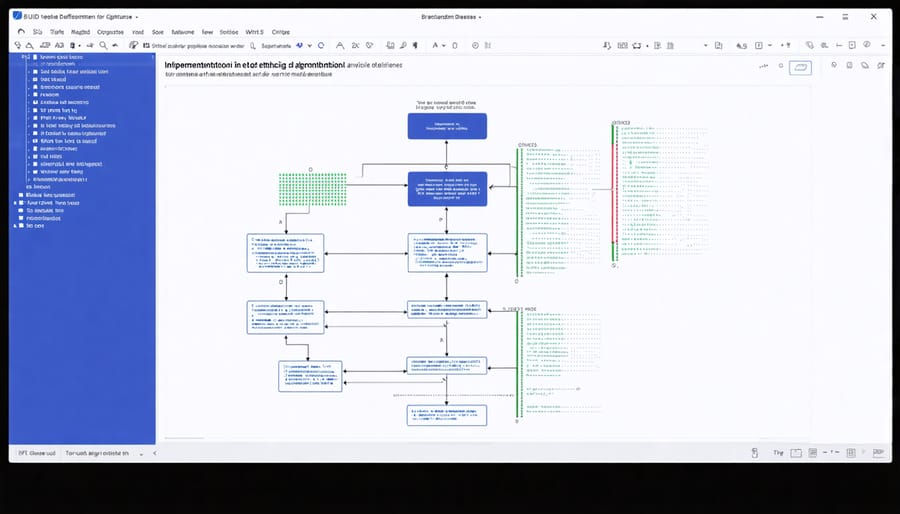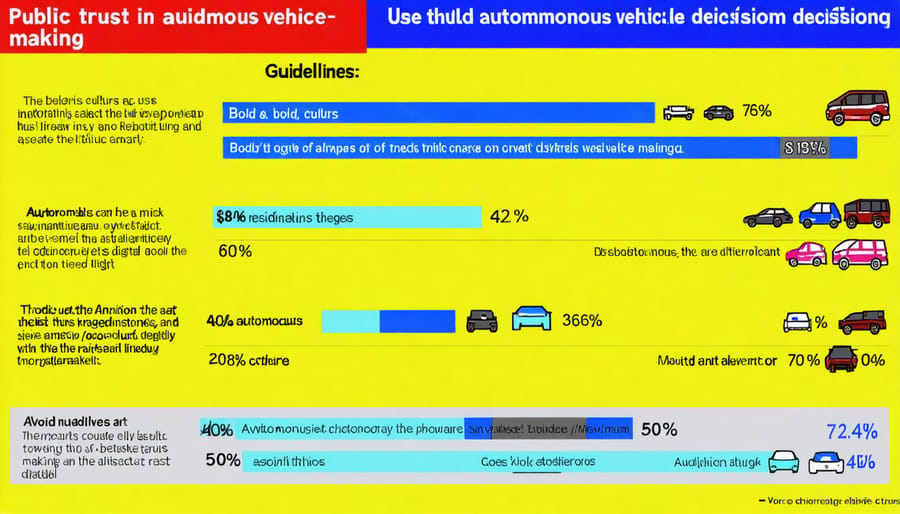Picture a self-driving car approaching an unavoidable collision. In a split second, it must decide: swerve to protect its passenger but endanger pedestrians, or prioritize saving the most lives at the expense of its occupant. This scenario, once confined to philosophy classrooms, now represents a real-world challenge as autonomous vehicles reshape our roads and force us to codify human ethics into algorithms.
The ethical programming of self-driving cars stands at the intersection of technology, morality, and public safety. Engineers and ethicists grapple with questions that have no clear answers: Should vehicles be programmed to always minimize casualties, even if it means sacrificing their passengers? How do we assign value to different human lives in critical moments? These decisions, traditionally made instinctively by human drivers, must now be precisely defined in lines of code.
As autonomous vehicles move from testing facilities to public streets, these ethical dilemmas demand immediate attention. The choices we make today in programming these vehicles will set precedents for artificial intelligence decision-making and shape public trust in autonomous systems for generations to come. Understanding this complex interplay between machine logic and human values is crucial for everyone involved in developing, regulating, or simply riding in the vehicles of tomorrow.
The Trolley Problem Goes Digital
Modern Moral Machines
In the realm of autonomous vehicles, split-second decisions can mean the difference between life and death. These modern machines must make autonomous moral decisions in complex scenarios where human judgment would typically prevail. Imagine a self-driving car approaching a situation where it must choose between swerving to avoid a group of pedestrians but potentially harming its passenger, or maintaining course to protect its occupant but risking multiple casualties.
Unlike humans who react instinctively, AI systems process these decisions through pre-programmed algorithms that weigh various factors: the number of lives at risk, legal obligations, and probability of different outcomes. These algorithms must account for countless variables in milliseconds – from weather conditions to vehicle speed, pedestrian behavior to road conditions.
What makes this challenge particularly complex is that these decisions must reflect our societal values while being reduced to mathematical calculations. Engineers and ethicists work together to create frameworks that balance utilitarian approaches with moral principles, ensuring these machines make decisions that are both ethically sound and technically feasible.

Real-World Complexity
While theoretical models often present clear-cut scenarios like the classic trolley problem, real-world situations faced by self-driving cars are far more nuanced and unpredictable. A simple binary choice between two outcomes rarely exists on actual roads. Instead, autonomous vehicles must process countless variables simultaneously – pedestrian movements, weather conditions, road quality, and the behavior of other vehicles – all while making split-second decisions.
Consider a scenario where a self-driving car encounters a child chasing a ball into the street during light rain. The car must instantly calculate numerous factors: the wet road’s stopping distance, the likelihood of the child changing direction, the presence of other vehicles, and potential evasive maneuvers – all while accounting for sensor reliability in adverse weather conditions.
Furthermore, real-world decisions often involve incomplete or imperfect information. Sensors may be partially obscured, visibility could be limited, or the behavior of other road users might be erratic. These uncertainties make it challenging to apply predetermined ethical frameworks consistently, highlighting the gap between theoretical solutions and practical implementation in autonomous vehicle systems.
Programming Ethics Into Code

Ethical Algorithms
Developers face the complex task of translating ethical principles into actionable code for self-driving vehicles. These AI ethical decision-making frameworks must balance multiple factors simultaneously, including passenger safety, pedestrian protection, and property preservation.
The most common approach involves implementing a hierarchical decision tree that prioritizes actions based on potential harm reduction. For example, when faced with an unavoidable collision scenario, the algorithm first considers options that minimize loss of human life, then evaluates choices that reduce severe injuries, and finally accounts for property damage.
Many developers incorporate the “trolley problem” variations into their testing scenarios, but real-world implementation is far more nuanced. Modern algorithms use probability weights and risk assessment matrices to make split-second decisions. These systems constantly evaluate thousands of potential outcomes, considering factors like weather conditions, road status, and the behavior of other road users.
To ensure transparency and accountability, developers are increasingly adopting “explainable AI” principles in their code. This means that every decision the vehicle makes can be traced back to specific programming rules and ethical guidelines. Regular testing and validation processes help refine these algorithms, while public input and ethical review boards provide crucial feedback for continuous improvement.
Testing and Validation
Testing autonomous vehicles’ ethical decision-making systems requires a comprehensive approach that combines simulation, controlled testing, and real-world validation. Manufacturers use sophisticated virtual environments to expose self-driving systems to millions of scenarios, including ethical dilemmas, before any real-world deployment.
These simulations present various scenarios where vehicles must make split-second ethical choices, such as choosing between two unavoidable accidents. The systems’ responses are analyzed against predetermined ethical frameworks and adjusted accordingly. Advanced machine learning algorithms learn from these scenarios, gradually improving their decision-making capabilities.
Physical testing occurs in controlled environments where real vehicles navigate through staged ethical scenarios using dummy obstacles and automated mechanical systems. These tests help verify that the theoretical responses match actual vehicle behavior. Third-party auditors and ethics boards regularly review test results to ensure compliance with established ethical guidelines.
Public road testing introduces another layer of validation, where vehicles operate in real traffic conditions under human supervision. Data collected from these tests helps refine the ethical decision-making algorithms and identifies edge cases that might have been missed in simulations.
Manufacturers also implement continuous monitoring systems that track and analyze ethical decisions made during operation, allowing for ongoing improvements and adjustments to the decision-making framework. This iterative process ensures that self-driving cars maintain consistent ethical behavior while adapting to new scenarios and societal expectations.
Cultural and Legal Considerations
Global Perspectives
The ethical approach to autonomous vehicles varies significantly across different cultures and regions, reflecting diverse social values and priorities. In Japan, for instance, the collective good often takes precedence over individual interests, leading to a preference for autonomous systems that prioritize minimizing overall casualties in accident scenarios.
By contrast, Western societies, particularly in the United States and Europe, tend to emphasize individual rights and personal autonomy. This cultural difference manifests in debates about whether self-driving cars should prioritize passenger safety over pedestrian safety, with many Western consumers expecting their vehicles to protect occupants first.
Chinese perspectives often align with Confucian values, emphasizing harmony and social order. This has led to greater acceptance of government-regulated AI decision-making in autonomous vehicles, with a focus on optimizing traffic flow and collective transportation efficiency.
Meanwhile, Indian culture’s emphasis on karma and the sanctity of life has sparked unique discussions about whether AI systems should consider factors like age, social status, or number of dependents when making split-second decisions.
These cultural variations present significant challenges for global automakers and AI developers, who must navigate different ethical frameworks while designing universal autonomous systems. Some companies are now implementing region-specific ethical algorithms, though this approach raises questions about the standardization of autonomous vehicle safety across international borders.
Legal Framework Challenges
The legal landscape surrounding autonomous vehicles presents a complex web of challenges that legislators and policymakers must navigate. Current regulations were designed for human drivers, making them inadequate for AI-driven vehicles that must make split-second ethical decisions. While some jurisdictions have begun adapting their laws to accommodate self-driving cars, there’s still significant uncertainty regarding liability in accident scenarios.
A key legal consideration revolves around determining responsibility when autonomous vehicles are involved in accidents. Should liability fall on the manufacturer, the AI system developer, or the vehicle owner? This question becomes particularly complex when considering the AI’s decision-making process in scenarios involving protecting human safety versus property damage.
Insurance frameworks also need substantial revision to accommodate autonomous vehicles. Traditional auto insurance policies assume human error as the primary risk factor, but with self-driving cars, the focus shifts to software malfunctions, sensor failures, and algorithmic decision-making errors.
Looking ahead, lawmakers must establish clear guidelines for programming ethical decisions into autonomous vehicles while ensuring these regulations remain flexible enough to accommodate rapid technological advancement. This includes creating standardized testing protocols for AI decision-making systems and establishing certification requirements that balance innovation with public safety concerns.
Public Trust and Acceptance
Transparency in Decision-Making
As autonomous vehicles become more prevalent on our roads, the need for transparent decision-making processes becomes increasingly crucial. The public needs to understand how these vehicles make split-second ethical choices, particularly in potential accident scenarios. This transparency isn’t just about building trust; it’s about ensuring accountability and fostering informed public discourse about the ethical frameworks governing these machines.
Car manufacturers and AI developers are now working to create explainable AI systems that can effectively communicate their decision-making processes. This includes developing user-friendly interfaces that can replay and explain critical moments, showing exactly why a vehicle made specific choices in challenging situations. However, this task is complicated by the presence of algorithmic bias in autonomous systems, which must be identified and addressed openly.
Several automotive companies have begun publishing their ethical guidelines and decision-making frameworks, allowing public scrutiny and feedback. These transparency initiatives typically include:
– Regular updates about the AI’s learning processes
– Clear documentation of safety protocols
– Public access to accident reports and decision analyses
– Interactive demonstrations of common ethical scenarios
This open approach helps build public confidence while also allowing experts to evaluate and improve the systems. It creates a feedback loop where public concerns can be addressed in subsequent updates to the vehicle’s decision-making algorithms. By maintaining this transparency, manufacturers can work collaboratively with communities to develop autonomous vehicles that reflect shared ethical values and priorities.

Building Trust Through Ethics
Building trust in autonomous vehicles requires a transparent and robust ethical framework that the public can understand and embrace. Companies developing self-driving cars are increasingly recognizing that ethical decision-making isn’t just about programming algorithms – it’s about creating systems that align with human values and societal expectations.
One effective approach is the implementation of “ethical by design” principles, where moral considerations are built into the development process from the start. This includes clear documentation of how vehicles make decisions in various scenarios and regular public engagement to gather feedback on these choices.
Manufacturers are also adopting standardized ethical guidelines, such as prioritizing human life over property damage and treating all human lives equally in unavoidable accident scenarios. By making these principles explicit and consistent across their autonomous vehicle fleet, companies help users understand and trust the decision-making process.
Public education plays a crucial role in building trust. When people understand how autonomous vehicles make ethical decisions, they’re more likely to accept and trust the technology. This includes explaining safety features, decision-making processes, and the extensive testing procedures these vehicles undergo.
Third-party ethical oversight and certification programs are emerging as another trust-building mechanism. These independent bodies evaluate autonomous vehicle systems against established ethical standards, providing unbiased verification of their safety and decision-making capabilities.
Regular transparency reports and real-world performance data sharing help maintain public confidence. When manufacturers openly discuss both successes and challenges in implementing ethical frameworks, it demonstrates their commitment to continuous improvement and responsible innovation.
As we navigate the complex landscape of autonomous vehicle development, the ethical challenges of programming moral decision-making continue to spark intense debate and innovation. While technological capabilities advance rapidly, the industry has yet to reach a universal consensus on how self-driving cars should handle life-or-death scenarios. Current approaches primarily rely on utilitarian frameworks that aim to minimize overall harm, but this solution remains contentious among both experts and the public.
The development of ethical AI decision-making systems has made significant progress, with manufacturers implementing sophisticated algorithms that can process multiple variables in split-second scenarios. However, these systems still face limitations in accounting for the nuanced moral contexts that humans naturally consider. The variation in cultural values and legal frameworks across different regions adds another layer of complexity to establishing standardized ethical guidelines.
Looking ahead, the future of autonomous vehicle ethics likely lies in a hybrid approach that combines rule-based programming with machine learning capabilities, allowing vehicles to adapt to different contexts while maintaining core safety principles. Ongoing collaboration between ethicists, engineers, policymakers, and the public will be crucial in developing frameworks that balance innovation with moral responsibility.
As we move forward, transparency in decision-making algorithms and continued public discourse will be essential in building trust and acceptance of autonomous vehicles, ultimately working toward a transportation system that’s not just efficient, but ethically sound.

